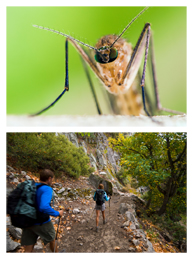
Mosquitoes
A worldwide nuisance and danger
Around 3000 species of mosquitoes are found worldwide. Their habitat stretches from the northern tip of Finland to the southern tip of Africa. In the marshlands of Alaska and Finland and in the former Soviet Union, swarms of mosquitoes actually blot out the sun and make life unbearable for men and animals.
Predominantly in the subtropics and tropics mosquitoes also spread epidemics. Some important species and diseases are listed (see table below). Malaria is the best known and most prevalent disease. It is transmitted by the Anopheles mosquito.
Why do mosquitoes bite?
Male mosquitoes are harmless vegetarians, content to feed on nectar and they do not bite. Females require a blood meal as a source of protein which is needed for egg production.
In order to find their host, mosquitoes are equipped with a sensory system that combines visual orientation as well as heat, humidity, carbon dioxide and chemical attractants. Attracting chemicals include various amino acids, ammonia, lactic acid, butyric acid and other substances excreted by human skin.
Mosquitoes ‘like’ the smell of their hosts, finding them by following the concentration gradient in the air. They fly in the direction from which the smell is strongest. To feed, the mosquito pierces the skin with its proboscis. This is a combined salivary and sucking tube. The piercing normally goes unnoticed, since the proboscis is very thin. A secretion is injected into the wound to dilate the blood vessels thereby increasing the flow of blood. Anti-coagulants are also secreted to prevent the blood from clotting. After the insect has sucked sufficient blood it leaves the host and will not attack another victim. It will drop the eggs and another life cycle of the insect begins.
A worldwide nuisance and danger
Around 3000 species of mosquitoes are found worldwide. Their habitat stretches from the northern tip of Finland to the southern tip of Africa. In the marshlands of Alaska and Finland and in the former Soviet Union, swarms of mosquitoes actually blot out the sun and make life unbearable for men and animals.
Predominantly in the subtropics and tropics mosquitoes also spread epidemics. Some important species and diseases are listed (see table below). Malaria is the best known and most prevalent disease. It is transmitted by the Anopheles mosquito.
Why do mosquitoes bite?
Male mosquitoes are harmless vegetarians, content to feed on nectar and they do not bite. Females require a blood meal as a source of protein which is needed for egg production.
In order to find their host, mosquitoes are equipped with a sensory system that combines visual orientation as well as heat, humidity, carbon dioxide and chemical attractants. Attracting chemicals include various amino acids, ammonia, lactic acid, butyric acid and other substances excreted by human skin.
Mosquitoes ‘like’ the smell of their hosts, finding them by following the concentration gradient in the air. They fly in the direction from which the smell is strongest. To feed, the mosquito pierces the skin with its proboscis. This is a combined salivary and sucking tube. The piercing normally goes unnoticed, since the proboscis is very thin. A secretion is injected into the wound to dilate the blood vessels thereby increasing the flow of blood. Anti-coagulants are also secreted to prevent the blood from clotting. After the insect has sucked sufficient blood it leaves the host and will not attack another victim. It will drop the eggs and another life cycle of the insect begins.

